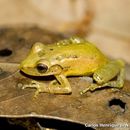Distribution
provided by IABIN
Coastal region from Espirito Santo to northern Rio Grande do Sul states, Brazil.
- author
- Esteban O. Lavilla
- editor
- Diego Arrieta
Molecular Biology
provided by IABIN
iodo, sais minerais, tanino, vitamina C, heterósido sulfurado(1)
Diagnostic Description
provided by IABIN
Adult morphology Size small, but not minute, females 25-32 mm, snout to vent; males 23-30. Build robust. Body almost uniform in width from eye to sacrum. Hind limb short, tibiotarsal articulation reaching the eye when adpressed. Snout triangular, wide at the base, narrow in front, sometimes appearing pointed beyond and below the nostrils. Canthus rostralis straight to the nostril, moderately distinct. Loreal region slightly concave. Nostrils subcanthal, small, slightly swollen. Eye prominent, slightly longer than the distance to nostril. Tympanum small, not more than one-third horizontal diameter of eye, very distinct. Tongue subcircular, slightly emarginate and free behind. Vomerine teeth in two short, subcontiguous groups between the small choanae. Disks short but well developed, especially on hand, rounded in front. Fingers free. Webs on toes more or less straight, reaching to below the disk on the outer side of second, third, and fifth toes, reaching to the penultimate tubercle on both sides of fourth toe. A tubercle below the first finger; palm well padded, especially below third and fourth fingers. An elongate inner, and a very small outer, metatarsal tubercle. Skin pustular on the back and sides; belly and midventral aspect of thigh granular. A glandular supratympanic ridge; distinct folds of skin below the gula and across the chest. Variation Specimens from Espirito Santo and those from Santa Catarina are mostly large and robust. Secondary sex characters are not marked except for the yellow gula of the male and the distension of the body by egg masses in the female. Some females attain larger size than males. Dorsal coloring in life (Rio de Janeiro population) dull, olivaceous brown or drab, variable in depth and intensity at different times in the same individual. Pattern darker. Tympanum a lighter brown. Upper part of iris iridescent; lower half is same color as sides of the head. Sometimes the entire body has a metallic glint. In males, the ventral surfaces of the body are whitish, and the gula is dull yellow. In females, the ventral surfaces of limbs are grayish, as is the gula. The pattern consists of two pairs of longitudinal dark stripes, or bands, separated by a lighter interval, plus an interocular spot and sometimes a vertebral line. Inner dorsal stripe more uniform and manifest; wider and longer than outer, dorsolateral one. In some individuals dark blotches behind the outer spot. Interval either the same color as the dorsal background or lighter, very conspicuous in juveniles. Interocular spot often absent or indistinct, variable in shape, sometimes reminiscent of a phrygean bonnet. Details and intensity of pattern very variable. Some specimens from the lowlands of the state of Rio de Janeiro have the inner dorsal stripe fragmented into a fore and a hind part and/or slightly curved inwards. In most specimens from Rio de Janeiro, the pattern is, however, inclined to simplification, with a conspicuous inner dorsal band, a very dark but short, narrow outer band and the rest of the pattern indistinct. The specimens from Espirito Santo have a more marked pattern on the back, often with a light halo around the dark bands which are variable in shape; these specimens also have a white area along the upper jaw. Most of the specimens from Santa Catarina have a marked dorsolateral pattern. A number of them show a light area at the edge of flank and thigh, obscure mottling on the concealed posterior part of the latter, and oblique spots or bands on the permanently visible dorsal aspect of the limbs. Larval morphology Mean total length at stage 36-37 (Gosner, 1960), 26.5 mm Body ovoid in dorsal view, approximately as wide as high; maximum height located about three-fourths body length in lateral view. Body length 32% of total length. Snout rounded in dorsal view. External nares small, rounded, located dorsally, and visible in lateral view, slightly closer to eyes than to snout. Internarial distance 82% of interorbital distance. Eyes lateral, their diameter about 31% of body height, interorbital distance 59% of body width and 1.8 times greater than eye diameter. Spiracle sinistral, short, slightly protuberant, located slightly beyond half of body, opening directed posteriorly. Vent tube short, dextral, attached to ventral fin. Tail slightly higher than body, gradually tapering to slender and rounded tip; point of maximum height of tail located about one-third tail length. Tail fins similar in height; dorsal fin arched, gradually ascending from posterior third of body. Oral disc anteroventral, about 36% of body width, with single row of marginal papillae extending ventrally and laterally, and with variable number of lateral submarginal papillae. Labial tooth row formula 2(2)/3(1); posterior labium with third tooth row short, prominent and about 53% of second tooth row. Jaw sheaths strong and finely serrated. Color in life: general color yellowish-brown covered with numerous dark brown spots and some golden and iridescent spots. Body in lateral view with dark brown stripe extending from snout to eyes; eyes coppery-brown. Venter iridescent copper; intestinal coils visible in lateral view. Tail with irregular brown markings. Tail fins translucent yellowish; base of ventral fin with marginal narrow brown stripe. Color in 5% formalin: body and tail musculature cream covered with dark brown spots and small irregular markings. Dark brown lateral stripe extending from snout to eyes. Spiracle transparent. Venter translucent with intestinal coils visible in lateral and ventral views. Tail with narrow brown stripe at base of ventral fin
- author
- Esteban O. Lavilla
- editor
- Diego Arrieta
Scinax alter: Brief Summary
provided by wikipedia EN
Scinax alter, the Crubixa snouted treefrog, is a species of frog in the family Hylidae endemic to Brazil.
- license
- cc-by-sa-3.0
- copyright
- Wikipedia authors and editors

